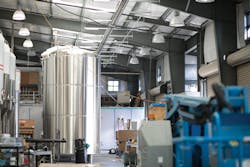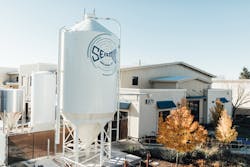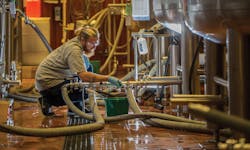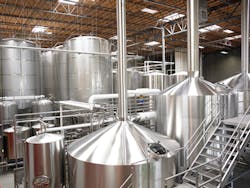Brewers Realize Advantages of Onsite Wastewater Treatment
By Alanna Maya
The next time you sit down with a cold pint of your favorite beer, think about this: it takes roughly eight pints of water to brew just one pint of beer. Brewing is a water-intensive industry, and brewers who successfully manage their wastewater will avoid paying high fees to manage their effluent and realize significant savings in the long term.
Generally speaking, brewery wastewater is high in sugar, alcohol, and solids, and comes with variable pH levels — all of which are problematic for a municipal wastewater treatment plant to handle. Surcharges (in addition to traditional wastewater fees) are one way that cities will recoup the expense of treating this varied wastewater, usually at a high cost depending on the time of year and volume of wastewater a brewery sends down the drain. With this in mind, some breweries are choosing to treat their effluent onsite to avoid high fees that could sink their operations over time.
In February 2017, Stone Brewery sent its last batch of wastewater to the City of Escondido for treatment. The California brewery’s onsite reuse system has eliminated the surcharges paid on the remaining wastewater that the brewery still sends down the drain.
Sustainability and Innovation
For Seismic Brewing Company in Santa Rosa, Calif., sustainability is at the heart of brewery operations.
“We try and instill sustainability and quality from the ground up in everything that we do, [from] the set of hands that is touching it to the ingredients we use and all the technology and education that we are doing around the community,” Director of Sustainability and Logistics Patrick Delves said.
Last year, Seismic produced about 2,000 barrels of beer, and this year, the company plans to produce about four times that amount. More beer means more wastewater, so Delves said the brewery is fortunate to have invested early in onsite treatment with Cambrian Innovation.
The treatment process includes a cycle of anaerobic digestion, followed by an aerobic cycle before the Cambrian unit’s electrogenic bacteria get to work fermenting and digesting any organic materials in the wastewater. Next, the water is ultra-filtered.
Seismic Brewing Company treats its wastewater onsite at its facility in Santa Rosa, Calif.
Photo: Andrea Lowry Photography.
“We take it a step further with tertiary treatment through reverse osmosis and ultraviolet treatment,” Delves said, “and then we are able to recapture that water, bring it back into the facility and do everything just shy of brewing with it — including steam generation, cleaning, and washdown.”
Delves said the facility currently reuses about 75-80 percent of its wastewater and hopes to scale up the process to increase that number in the future.
“For a facility of our size, in initial [wastewater] hookup fees, we would pay close to a quarter of a million dollars,” Delves said. Because of Seismic’s onsite wastewater treatment, Delves said they were actually able to bypass that cost. “We [also] aren’t paying much of anything in the way of discharge fees to the sewer, so the savings there last year were about $10,000-15,000, and that will keep growing.”
Seismic Brewing Company operates an EcoVolt MINI from Cambrian Innovation to treat brewery effluent onsite. The unit uses electrogenic bacteria to dissolve organic compounds in the wastewater. Photo: Andrea Lowry Photography.
Side Streaming Success
Located in Grand Rapids, Mich., Founders Brewing Company is an award-winning brewery that has experienced explosive growth in the last 10 years. Ranked the 15th largest brewery in the United States based on 2017 volume, this year the brewery expects to ship out about 650,000 barrels of beer. But all that growth, according to Founders’ Chief Production Officer Brad Stevenson, has brought with it some challenges.
“As we’ve grown, a lot of things went down the drain that we didn’t keep track of,” Stevenson said. “Our local municipality helped us recognize that [and] that we needed to know what those were.” Over the last several years, Stevenson said they’ve had to build the knowledge base and adopt technology to handle their wastewater more efficiently.
The City of Grand Rapids specifically had trouble managing the heavy loads of biological oxygen demand (BOD) and total suspended solids (TSS) coming from the Founders facility and levied high surcharges on the brewery. This motivated the company to examine its wastewater profile, and to install a side streaming system to manage high-strength waste from the brewing process.
“We [now] take tank bottoms, solids, and everything that we used to call liquid waste and collect [it] before going down the drain, and that lowered our BOD significantly,” Stevenson said. “We actually then found a resource for that. We now call it a liquid byproduct stream instead of a waste stream.”
In a continued partnership between Founders and the city, a designated pipe delivers nutritionally rich effluent from the brewery to the wastewater treatment plant.
“The municipality had a need for the nutrition of what was still coming down the drain … so they side stream our effluent and they hold it for when they need extra nutrition in their system,” Stevenson explained. “That has allowed our surcharges to drop further.”
Founders Brewing Company began side streaming brewery waste to avoid the high surcharges and fees the local municipality charged for sending these items down the drain.
Off the Grid
With a production run of about 300,000 barrels a year, it’s quite impressive that Stone Brewing Company was able to reclaim about 17 million gallons of water last year at its Escondido, Calif., brewery. But for Charlie Arnold, it’s just the way they do things at Stone.
“Water is the most important part of the brewing process — about 80 percent worth,” the water operations supervisor said. “Our wastewater [is managed through] aerobic treatment with a membrane bioreactor (MBR), and then complete reverse osmosis recycling to the tune about 70,000 gallons a day. We reclaim everything we can use again and then all the industrial brine is discharged.”
The brewery maintains an NPDES permit for discharging to the Pacific Ocean, which ensures their treatment meets the strict standards set forth by the Environmental Protection Agency (EPA), but it has other benefits as well: mainly being off the municipal wastewater “grid.”
Stone Brewing Company’s Escondido brewery generates about 70,000 gallons per day of reclaimed water per production day. In 2017, the facility recycled about 17 million gallons of water.
“We never have to send [our wastewater] to the municipality,” Arnold said. In fact, February 2017 was the last time the brewery sent wastewater to the City of Escondido for treatment or disposal. Arnold said the reuse system has eliminated the surcharges paid on the remaining wastewater that the brewery still sends down the drain, while furthering the company’s sustainability goals.
“It’s at the heart of Stone’s mission, and it helps us and the City of Escondido at the same time,” he said. IWW
About the Author: Alanna Maya is the assistant editor for WaterWorld and Industrial WaterWorld magazines. Email her at [email protected].







